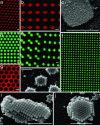Arranging matter by magnetic nanoparticle assemblers
- PMID: 15956215
- PMCID: PMC1150276
- DOI: 10.1073/pnas.0500409102
Arranging matter by magnetic nanoparticle assemblers
Abstract
We introduce a method for transporting colloidal particles, large molecules, cells, and other materials across surfaces and for assembling them into highly regular patterns. In this method, nonmagnetic materials are manipulated by a fluid dispersion of magnetic nanoparticles. Manipulation of materials is guided by a program of magnetic information stored in a substrate. Dynamic control over the motion of nonmagnetic particles can be achieved by reprogramming the substrate magnetization on the fly. The unexpectedly large degree of control over particle motion can be used to manipulate large ensembles of particles in parallel, potentially with local control over particle trajectory.
Figures





References
-
- Dufresne, E. R. & Grier, D. G. (1998) Rev. Sci. Instrum. 69, 1974–1977.
-
- Curtis, J. E., Koss, B. A. & Grier, D. G. (2002) Opt. Comm. 207, 169–175.
-
- Velev, O. D., Prevo, B. G. & Bhatt, K. H. (2003) Nature 426, 515–516. - PubMed
-
- Ozin, G. A. & Yang, S. M. (2001) Adv. Funct. Mater. 11, 95–104.
LinkOut - more resources
Full Text Sources
Other Literature Sources

